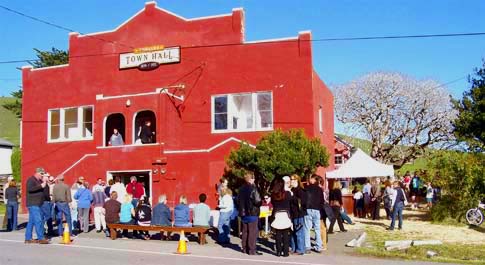Tue 31 Mar 2009
Crowd in Inverness Friday calls for reviving park’s Citizens Advisory Commission
Posted by DavidMitchell under agriculture, General News, History, Inverness, Marin County, Photography, The Point Reyes Light Newspaper, West Marin nature, Wildlife
1 Comment
Against my better judgment I showed up for Friday’s “Community Conversation” concerning the Point Reyes National Seashore’s intention to close Drakes Bay Oyster Company. Since retiring three years ago, I’ve continued to write about public issues in West Marin, but I haven’t taken part in many political events. Having achieved Nirvana, I’d rather not disturb it.
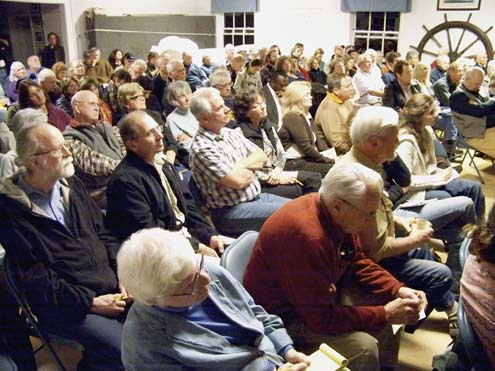
But Friday evening, I was one of 125 or so West Marin residents who filled the Inverness Yacht Club for a heavily structured discussion of the park.
Sounding like marriage counselors, a team of moderators started the meeting by telling us we were there to express our feelings, not to present facts.
To avoid bad feelings, we couldn’t criticize anybody by name (e.g. National Seashore Supt. Don Neubacher) but could only refer to his organization (e.g. “the park”). In fact, the moderators later called me out for naming names when I said President Obama is an improvement over President Bush.
The members of a “community” need to “communicate,” the moderators said more than once. No speaker should hog the microphone, they added, but were themselves slow to relinquish it. After more than half an hour of a two-hour meeting had been spent on these introductory comments with no letup in sight, I began eying the door next to me only to discover it merely went to a fire escape. On the other hand, the moderators’ efforts to ensure parlor-like decorum did pay off. I can recall more acrimony during a public discussion of museum hours.
Phyllis Faber told the group that Supt. Neubacher was away but had said that even if he were in town, he wouldn’t attend.
Faber added that Neubacher also said the park’s associate superintendent was likewise out of town but would have attended were she here. (Faber is co-founder of MALT, a fellow of the California Native Plant Society, and an author of a botanical guide, so her account is probably reliable.)

At the Drakes Bay Oyster Company site (seen here), oysters are sold and canned. A Park Service use permit, which expires in 2012, is strictly for these onshore facilities and not for oyster growing in the estero itself, which has been designated “potential wilderness.” Neubacher supporters have claimed that extending the onshore facilities’ use permit would be a threat to wilderness nationwide because of the precedent it would set. Others claim that makes neither legal nor logical sense.
Gordon Bennett, a member of the Marin Group of the San Francisco Bay Chapter of the national Sierra Club, has been carrying Neubacher’s water (not always with the support of his group) ever since the park superintendent three years ago first proposed shutting down the oyster company come 2012. On the eve of Friday’s meeting, Bennett sent an email to those sympathetic to Neubacher, warning them off by claiming the meeting was a “set-up” which had been “organized by proponents” of the oyster company.
It’s hard to tell whether the email had any effect. Some members of the Environmental Action Committee of West Marin, which supports Neubacher’s position, were on hand, including its president and a former board member. A couple of people, including forester Tom Gaman of Inverness, said the park should get rid of the oyster company to create wilderness.
Most of those who spoke, however, like most West Marin residents one hears on the street, supported the company. Several people, such as innkeeper Frank Borodic of Olema, said the oyster company is well run and good for the environment.
After two hours, however, only a couple of proposals got virtually unanimous support from the audience: 1) have additional oyster-company critics at future Community Conversations in order to create more of a dialogue; 2) get Congresswoman Lynn Woolsey to introduce legislation resurrecting the Citizens Advisory Commission to the GGNRA and Point Reyes National Seashore.
Because the two parks were established to serve the Bay Area’s mostly urban population, Congress in 1972 decided that Bay Area local governments should nominate candidates for a Citizens Advisory Commission, which would then be appointed by the US Secretary of the Interior.
Since they were appointed by a member of the president’s cabinet, the commissioners’ decisions, while only advisory, carried weight with the park administration. A superintendent could not ignore them without risking his job, former Supt. John Sansing once told me.

Supt. Neubacher and his staff have tried to discredit Drakes Bay Oyster Company by telling county and federal officials that seals are frightened away by the growing and harvesting of oysters. Apparently not having heard about this, the 18 harbor seals seen here are sunning themselves on oyster racks in neighboring Tomales Bay.
The advisory commission had needed Congressional reauthorization every few years, and for almost three decades, Congress approved it. However, in 2002, its term expired, and with Republicans in charge of Congress and the White House, the commission was allowed to die.
This time [then-Interior Secretary] Gale Norton and the Park Service said, “It’s been a very good commission for 29 years, but we don’t need it anymore,” former Commissioner Amy Meyer told me in 2007. National Seashore spokesman John Dell’Osso in 2004 had already told me the park administration did not want the commission revived because it sometimes interfered with what the Park Service felt should be done.
The Neubacher administration has also argued that local residents don’t speak for all Americans. It’s a specious argument since most park visitors are from the nine-county Bay Area and are far more familiar with the park, and with anything going wrong in it, than are people in other parts of the country, who seldom, if ever, see the National Seashore.
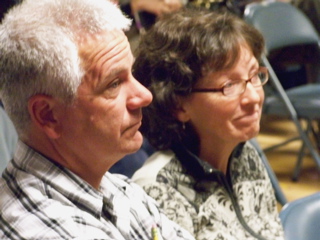 Closely following Friday’s discussion are oyster company owners Kevin and Nancy Lunny.
Closely following Friday’s discussion are oyster company owners Kevin and Nancy Lunny.
Meyer noted the commission had acted as an “interface” between the public and the park, and its absence has been felt. In the past four years, there has been widespread public dissatisfaction with the National Seashore over: 1) a 2004 ranger-pepper-spray scandal; 2) the inhumane slaughter of non-indigenous deer a year ago; 3) the present oyster-company dispute. Without the advisory commission to provide the public with a forum for resolving these issues, they have become so contentious that Supt. Neubacher is seldom seen around town anymore.
Congresswoman Woolsey four years ago introduced legislation to resurrect the commission, and it was attached to a House bill (which was being pushed by now-Speaker Nancy Pelosi and others) to acquire land in San Mateo County for the GGNRA. The bill passed in 2005, but when it did, the rider resurrecting the commission was gone.
Meyer said she and other people went to Congresswomen Pelosi and Woolsey, asking that they temporarily drop the advisory-commission legislation. The fear, Meyer said, was that the Bush Administration would pack the advisory commission with people who shared his ideology.
On Friday night, I suggested that since we now have the Obama administration, the time is ripe to resurrect the commission. A number of other speakers, including Liza Crosse, aide to Marin County Supervior Steve Kinsey, agreed. And when a show of hands was taken later, almost everyone supported the idea, regardless of where they stood on the oyster-company issue.


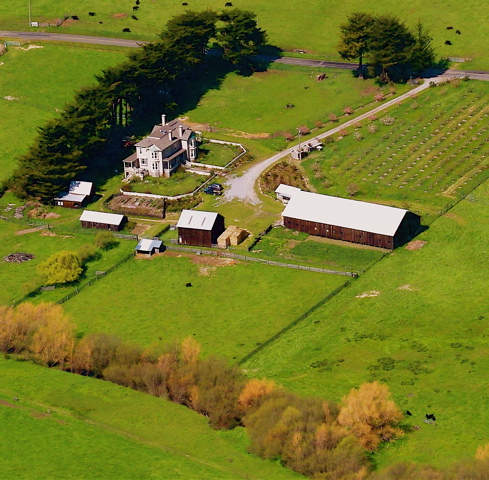

 The “most common industries for males” working in West Marin, City-Data.com says, are: “construction, 17 percent; professional, scientific, and technical services, 10 percent; agriculture, forestry, fishing and hunting, 10 percent; educational services, 8 percent; accommodation and food services, 7 percent; health care, 5 percent; arts, entertainment, and recreation, 5 percent.”
The “most common industries for males” working in West Marin, City-Data.com says, are: “construction, 17 percent; professional, scientific, and technical services, 10 percent; agriculture, forestry, fishing and hunting, 10 percent; educational services, 8 percent; accommodation and food services, 7 percent; health care, 5 percent; arts, entertainment, and recreation, 5 percent.”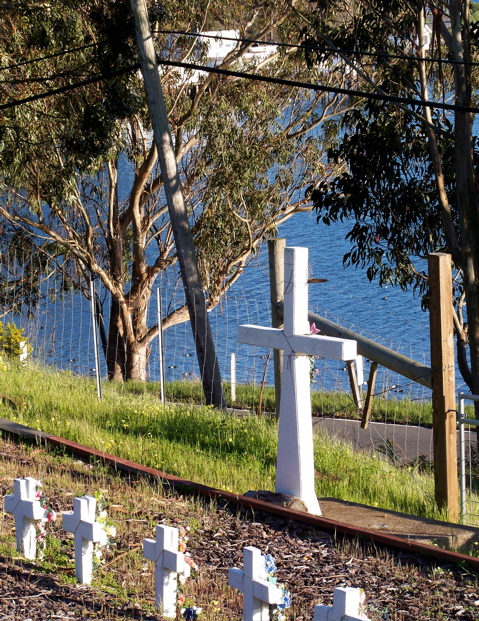 The Miwok Indian cemetery at Reynolds (where Tony’s Seafood is located; the restaurant’s white buildings can be seen in the background) From 1875 to 1930, Reynolds was a whistlestop on the narrow-gauge railroad, and numerous Miwoks lived nearby. A few of their descendants still do. The cemetery belongs to the Miwok Rancheria in Graton, Sonoma County.
The Miwok Indian cemetery at Reynolds (where Tony’s Seafood is located; the restaurant’s white buildings can be seen in the background) From 1875 to 1930, Reynolds was a whistlestop on the narrow-gauge railroad, and numerous Miwoks lived nearby. A few of their descendants still do. The cemetery belongs to the Miwok Rancheria in Graton, Sonoma County.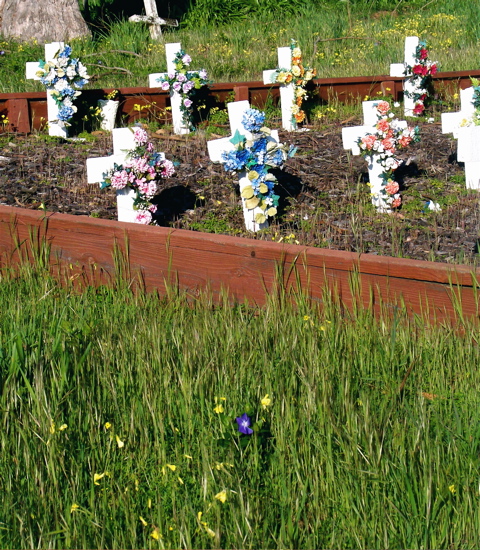 Today, of course, is the first day of Spring, and wildflowers have begun blooming around the plastic flowers that decorate each cross.
Today, of course, is the first day of Spring, and wildflowers have begun blooming around the plastic flowers that decorate each cross.

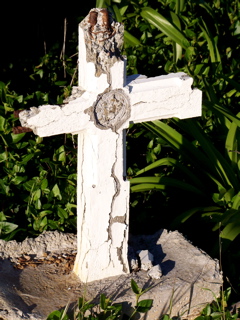 “The heart of the group’s activity, listed cryptically on its Web site’s calendar as ‘morning practice,’ is closed to all but the residents. At 7 a.m. each day,” The Times reports, “about a dozen women, naked from the waist down, lie with eyes closed in a velvet-curtained room, while clothed men huddle over them, stroking them in a ritual known as orgasmic meditation,” ‘OMing,’ for short.
“The heart of the group’s activity, listed cryptically on its Web site’s calendar as ‘morning practice,’ is closed to all but the residents. At 7 a.m. each day,” The Times reports, “about a dozen women, naked from the waist down, lie with eyes closed in a velvet-curtained room, while clothed men huddle over them, stroking them in a ritual known as orgasmic meditation,” ‘OMing,’ for short.
 A warning sign of Spring: Hundreds of people showed up at the Dance Palace this afternoon for Sacred Heart Church’s annual St. Patrick’s Day Barbecue.
A warning sign of Spring: Hundreds of people showed up at the Dance Palace this afternoon for Sacred Heart Church’s annual St. Patrick’s Day Barbecue.
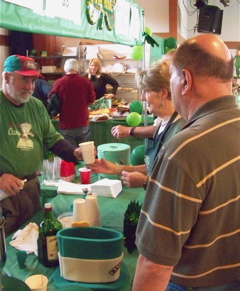 A volunteer bartender at the St. Patrick’s Day Barbecue, Mark Allen (left) of Inverness Park, takes an order for an Irish coffee.
A volunteer bartender at the St. Patrick’s Day Barbecue, Mark Allen (left) of Inverness Park, takes an order for an Irish coffee.
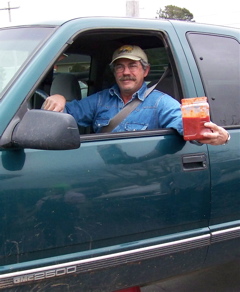

 Another warning sign of Spring: The gloomy days of winter are supposed to be over “when the red, red robin comes bob, bob, bobin’ along.” But at Jay’s home this year, the first robin of Spring is not “red, red” but partially albino. (Photo by Jay Haas)
Another warning sign of Spring: The gloomy days of winter are supposed to be over “when the red, red robin comes bob, bob, bobin’ along.” But at Jay’s home this year, the first robin of Spring is not “red, red” but partially albino. (Photo by Jay Haas)